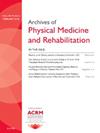Evaluation of the Content Validity of an Activity-based Therapy Tracking Tool Using Cognitive Debriefing Interviews
IF 3.6
2区 医学
Q1 REHABILITATION
Archives of physical medicine and rehabilitation
Pub Date : 2025-04-01
DOI:10.1016/j.apmr.2025.01.078
引用次数: 0
Abstract
Objectives
To evaluate the content validity of a prototype activity-based therapy (ABT) tracking tool to be used by clinicians and people living with spinal cord injury or disease (SCI/D) who participate in ABT.
Design
A qualitative study involving cognitive debriefing interviews.
Setting
Three community-based ABT clinics in Canada. Interviews were held over web conferencing.
Participants
A volunteer sample of 9 clinicians (1 physical therapist, 7 kinesiologists, 1 exercise physiologist; 2 men, 7 women; mean age, 27.8±3.9y) and 5 persons with SCI/D (5 traumatic tetraplegia; 2 complete, 3 incomplete; 2 men, 3 women; mean age, 32.4±7.8y) were recruited through a poster campaign at 3 community-based ABT clinics in Canada. To be eligible, clinicians and individuals with traumatic or nontraumatic SCI/D (>6mo) had to participate in ABT at least once a week for 2 months.
Interventions
Not applicable.
Main Outcome Measures
Participants used a paper-based ABT tracking tool over 3 ABT sessions, and then completed an individual, semistructured interview that used cognitive debriefing. The interview guide followed recommendations by Brod and colleagues for determining content validity by probing the appropriateness, comprehensiveness and comprehensibility of the tool. Participants were also probed on how the tool was used and perceived barriers and facilitators of tool use and implementation into practice. A deductive followed by an inductive content analysis was used.
Results
The ABT tracking tool demonstrated content validity. Three themes were identified. (1) Content validity of the ABT tracking tool. The tool was comprehensive and appropriate for all levels and severities of injury. Recommendations, such as adding a comment section and additional parameters to each activity were provided to improve the tool. (2) Facilitators of tool use, dissemination and implementation. Participants perceived using the tool during rest breaks to maximize therapy time or immediately after the session to avoid recall issues. Education and training on use of the tool in an app form would support implementation. Social media and community clinics could aid in dissemination. (3) Barriers of tool use, dissemination and implementation. Anticipated barriers included the paper format, language barrier for nonnative English speakers, learning curve, added workload and adapting a new documentation system.
Conclusions
A validated ABT tracking tool may provide a convenient and standardized approach to document the details of ABT sessions within a community-based setting. Addressing anticipated barriers, such as creating an app and developing learning resources to support its use, are important next steps.
Supported by Praxis Spinal Cord Institute.
Disclosures
none.
求助全文
约1分钟内获得全文
求助全文
来源期刊
CiteScore
6.20
自引率
4.70%
发文量
495
审稿时长
38 days
期刊介绍:
The Archives of Physical Medicine and Rehabilitation publishes original, peer-reviewed research and clinical reports on important trends and developments in physical medicine and rehabilitation and related fields. This international journal brings researchers and clinicians authoritative information on the therapeutic utilization of physical, behavioral and pharmaceutical agents in providing comprehensive care for individuals with chronic illness and disabilities.
Archives began publication in 1920, publishes monthly, and is the official journal of the American Congress of Rehabilitation Medicine. Its papers are cited more often than any other rehabilitation journal.

 求助内容:
求助内容: 应助结果提醒方式:
应助结果提醒方式:


